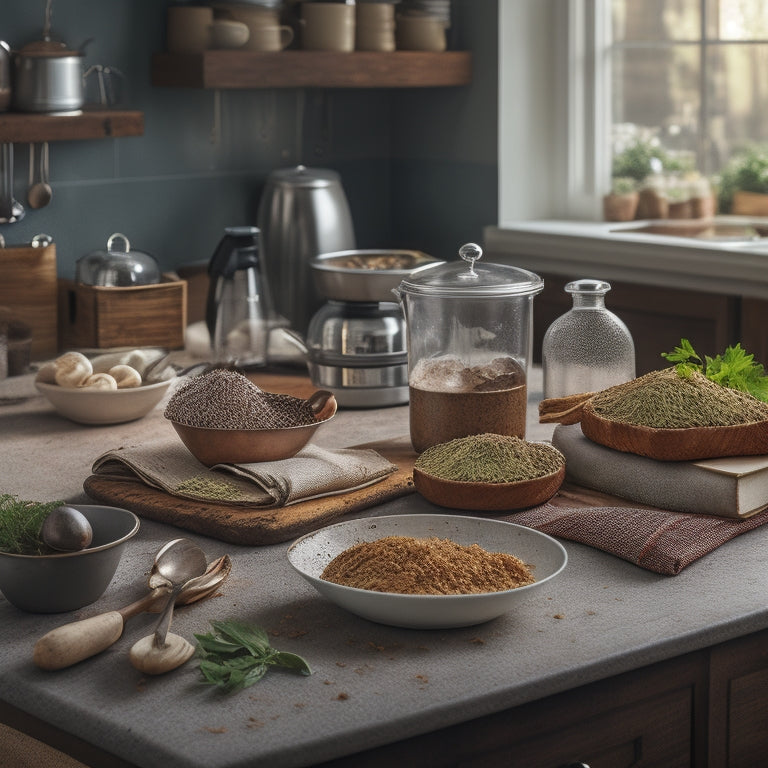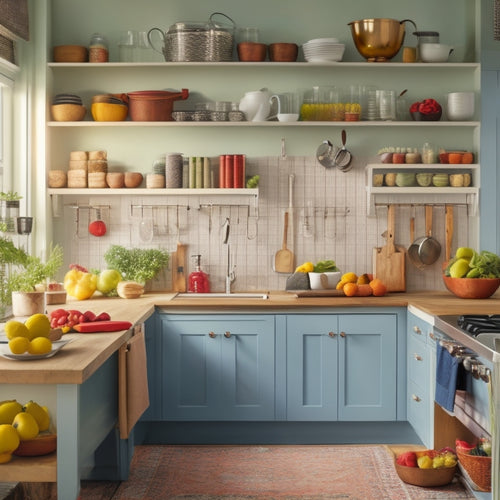
Why Kitchen Clutter Persists Despite Best Intentions
Share
You've tidied up your kitchen, but clutter keeps creeping back in. You're not alone. Despite your best efforts, kitchen clutter persists due to various reasons. Unrealistic expectations of perfection, fueled by social media, can lead to frustration and abandoned organizing attempts. Inadequate storage solutions, poor meal planning, and inefficient kitchen layouts also contribute to the problem. Additionally, inconsistent cleaning habits and failure to assign task stations can hinder your efforts. You're likely struggling with a combination of these factors. To break the cycle of clutter, take a closer look at your kitchen's trouble spots and get ready to uncover strategies to overcome them.
Key Takeaways
• Unrealistic perfection expectations fueled by social media can hinder efforts to maintain a clutter-free kitchen, leading to feelings of inadequacy.
• Inadequate storage solutions, such as lack of pantry organization or inefficient use of countertops, can contribute to persistent clutter.
• Failure to implement and stick to meal planning strategies can result in last-minute takeout orders and food waste, perpetuating clutter.
• Insufficient task stations and zones in the kitchen can lead to mess accumulation and decreased productivity, making clutter more likely.
• Unrealistic expectations of a "perfect" kitchen can distract from creating a functional and comfortable cooking space, allowing clutter to persist.
Kitchen Clutter Hotspots Exposed
You'll likely find that clutter tends to accumulate in five key areas of your kitchen, which we'll refer to as kitchen clutter hotspots. These areas are prone to disorganization due to their high usage and the nature of the items stored in them.
The first hotspot is your pantry. Poor pantry organization can lead to expired or spoiled food, not to mention the time wasted searching for ingredients. To tackle this, start by purging expired items and grouping similar products together. Consider using baskets, bins, or shelves to maximize storage space.
Another hotspot is your countertop, which can quickly descend into chaos. Countertop chaos is often caused by appliances, gadgets, and cluttered workspaces. To regain control, designate specific zones for different activities, such as a coffee station or a baking area. Implementing a 'one in, one out' policy for gadgets and appliances can also help maintain a sense of order.
Unrealistic Expectations of Perfection
Your pursuit of a perfectly organized kitchen is likely fueled by social media's curated images and unrealistic expectations, which can lead to frustration and disappointment when reality falls short. The pressure to achieve perfection can create mental clutter, making it harder to focus on what really matters – creating a functional and comfortable cooking space that works for you.
You're not alone in feeling this way; societal standards often perpetuate unrealistic ideals, making it difficult to accept your own kitchen's imperfections.
It's essential to recognize that perfection is an unattainable goal, and it's okay to have a kitchen that's 'good enough.' Self-acceptance is key to breaking free from the perfection pressure. By letting go of unrealistic expectations, you can shift your focus to creating a space that truly reflects your needs and personality.
Lacking Clear Storage Solutions
Now that you've freed yourself from the pressure of achieving a perfect kitchen, it's time to tackle the nitty-gritty issue of storage solutions, which can make or break the functionality of your cooking space.
Without a clear plan, clutter will inevitably creep back in, no matter how hard you try to maintain order. That's why investing in custom organizers tailored to your specific needs is essential. These solutions can help you maximize space utilization, ensuring every inch of your kitchen is used efficiently.
Take stock of your kitchen's unique challenges and identify areas where clutter tends to accumulate. Are your countertops overrun with appliances? Do your cabinets lack clear categorization? Once you've pinpointed these trouble spots, you can start designing a storage system that works for you.
Consider installing shelves, hooks, or baskets that keep frequently used items within easy reach. By streamlining your storage, you'll be able to focus on cooking rather than searching for lost ingredients or utensils.
With a well-thought-out storage plan, you'll be empowered to take control of your kitchen and keep clutter at bay.
Inadequate Meal Planning Strategies
Three-quarters of kitchen clutter can be attributed to inadequate meal planning strategies, which lead to last-minute takeout orders, forgotten leftovers, and a plethora of unused ingredients.
You know the drill: you're tired, you don't know what to cook, and you end up ordering pizza or buying unnecessary items at the grocery store. This lack of planning not only contributes to clutter but also wastes your time and money.
To break this cycle, you need to develop a meal planning strategy that works for you. Start by setting aside time each week to plan out your meals and make a corresponding grocery list. This will help you avoid buying unnecessary items and reduce food waste.
Effective time management is key here - allocate specific times for meal planning, grocery shopping, and cooking. By doing so, you'll be able to cook healthy meals, reduce kitchen clutter, and free up time for more important things.
Take control of your kitchen and start planning your meals today!
Digital Kitchen Design Templates
You can optimize your kitchen's layout and declutter its contents by utilizing digital kitchen design templates. These templates allow you to visualize and experiment with different layouts before making any physical changes. This virtual organization tool helps you identify areas of inefficiency and create a more functional space.
By experimenting with different layouts, you can achieve space optimization, making the most of your kitchen's square footage.
With digital design templates, you can try out different cabinet configurations, countertop layouts, and appliance arrangements without committing to a specific design. This allows you to test various scenarios, identify potential issues, and make adjustments before investing in renovations or new furniture.
You can also use these templates to explore different styles, from modern to traditional, and get a sense of how they'll look in your kitchen.
Poor Kitchen Layout Design
A poorly designed kitchen layout can lead to clutter accumulation, as inefficient use of space and impractical workflows encourage chaos and disorganization. You may have the best intentions to keep your kitchen organized, but if the layout isn't functional, clutter will inevitably build up.
Cramped spaces and narrow walkways make it difficult to move around, causing you to leave items out simply because there's no room to put them away. Additionally, an inefficient workflow can lead to clutter hotspots, such as countertops and sink areas, becoming overwhelmed with dishes, utensils, and appliances.
To combat this, take a closer look at your kitchen's layout. Identify areas where traffic flow is restricted and spaces that are underutilized. Consider rearranging your layout to create a more efficient workflow. This might involve relocating appliances, installing shelves or cabinets, or even reconfiguring your countertops.
Inconsistent Cleaning Habits
Your inconsistent cleaning practices are likely a significant contributor to the clutter that has overtaken your kitchen. Clutter psychology informs us that clutter accumulates when we aren't attentive to our behaviors and surroundings.
If you aren't upholding a consistent cleaning schedule, clutter will inevitably seep in. Recognizing the role habit formation plays in maintaining your kitchen's organization is vital. You can't simply declutter your space and expect it to remain that way without investing effort in its upkeep.
To address this issue, consider implementing organization tricks such as establishing a specific cleaning timetable or adopting a 'clean-as-you-go' approach. This will assist you in managing messes and preventing clutter from piling up.
Cultivating a declutter mindset is fundamental in preserving a neat kitchen. By being more aware of your cleaning practices and turning them into habits, you'll be better prepared to keep your kitchen orderly and free of clutter. Remember, it's all about establishing a routine that suits you and adhering to it.
Failure to Assign Task Stations
Most kitchens lack a clear division of tasks, leading to cluttered countertops and inefficient workflow. You're not alone if your kitchen feels like a chaotic mess, with utensils scattered everywhere and tasks piling up. One major culprit behind this chaos is the failure to assign task stations.
Without designated areas for specific tasks, such as prep work, cooking, and cleaning, your kitchen becomes a breeding ground for clutter and disorganization.
Assigning task stations is vital for effective clutter organization and task delegation. By designating specific zones for different tasks, you'll be able to contain the mess and focus on one task at a time. This approach will also help you identify areas where you need more storage or counter space, allowing you to make adjustments and optimize your kitchen's layout.
Take control of your kitchen by assigning task stations and streamlining your workflow. You'll be amazed at how this simple strategy can transform your cooking experience and reduce clutter.
Frequently Asked Questions
How Do I Declutter My Kitchen When Family Members Resist Change?
"Did you know 75% of people feel anxious in cluttered spaces? You're not alone in this struggle. To declutter your kitchen despite family resistance, involve them in the process, addressing their concerns and creating a personalized organization plan that respects your family dynamics."
Are There Any Apps That Help Organize Kitchen Storage and Inventory?
You can utilize apps like StillTasty or FreshBox to create a virtual pantry and streamline inventory management, helping you stay on top of kitchen storage and organization, and making meal planning a breeze.
Can a Small Kitchen Still Be Functional With Clutter?
You can create a functional small kitchen despite clutter by implementing space-saving solutions like vertical storage, multi-functional appliances, and a well-planned layout that incorporates functional design, allowing you to work efficiently in a compact space.
What Are Some Creative Ways to Repurpose Old Kitchen Items?
You're likely among the 77% of Americans who own unused kitchen gadgets. Turn them into functional gems! Upcycle old items into DIY organization tools, like a utensil organizer from a mason jar or a pot lid holder from a wooden spoon.
How Often Should I Deep Clean My Kitchen to Maintain Organization?
You should deep clean your kitchen regularly to maintain organization. Aim for weekly maintenance, a monthly overhaul, seasonal decluttering, and an annual deep clean to keep your kitchen organized and clutter-free.
Related Posts
-

5 Best Kitchen Organization Templates With Shopping Lists
You're looking to transform your kitchen into a culinary haven with the help of organization templates and shopping l...
